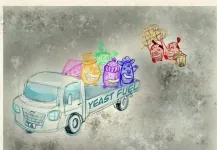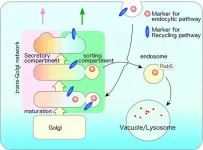(Press-News.org) It is impossible to imagine modern agriculture without plastics. 12 million tonnes are used every year. But what about the consequences for the environment? An international team of authors led by Thilo Hofmann from the Division of Environmental Geosciences at the University of Vienna addresses this question in a recent study in Nature Communication Earth and Environment. The research shows the benefits and risks of using plastics in agriculture, and identifies solutions that ensure their sustainable use.
Once celebrated as a symbol of modern innovation, plastic is now both a blessing and a curse of our time. Plastic is ubiquitous in every sector, and agriculture is no different. Modern agriculture, which is responsible for almost a third of global greenhouse gas emissions and is a major drain on the planet's resources, is inextricably linked to plastic. The new study from the University of Vienna was conducted by Thilo Hofmann, environmental psychologist Sabine Pahl and environmental scientist Thorsten Hüffer, along with international co-authors. Their research reveals that plastic plays a multi-faceted role: from mulch films that protect plants to water-saving irrigation systems, plastic is deeply embedded in our food production.
Plastic enhances yields while shrinking our ecological footprint
According to the Food and Agriculture Organisation of the United Nations (FAO), over 12 million tonnes of plastic are integrated into the agricultural process every year. From securing plants with clamps to protecting them with nets, plastic has found its place in all areas of agricultural production. The use of plastic in agriculture undeniably conserves important resources. The front-runner is mulch films, which account for about 50% of all agricultural plastics. Mulch films not only control weeds and pests, but also preserve soil moisture, regulate temperature, and improve nutrient uptake, thus helping to reduce the ecological footprint of agriculture. In China, not using mulch films would require an additional 3.9 million hectares of cropland to maintain the status quo of production.
The dark side of plastic in our food systems
But the intensive use of plastics in agriculture also has downsides: impaired soil fertility, dwindling crop yields, and the chilling prospect of toxic additives seeping into our food chain. Conventional plastics persist in the environment, with residues accumulating in our soils. Tiny plastic particles can be ingested by plants. Although research into the uptake of nanoplastics is still in its infancy, preliminary data suggests that plastics can enter our food chain through agriculture.
Our transition from plastic should be slow and calculated
In navigating the challenges of plastic in agriculture, the spotlight falls on a strategy that champions the rational use of plastic, its efficient collection post-use, and the innovation of cutting-edge recycling methods, the authors state in the new study. "In cases where plastics remain in the environment, their design should ensure complete biodegradation. Furthermore, it is crucial that toxic plastic additives are replaced by safer alternatives," explains Thilo Hofmann
While bio-based materials present a tempting alternative, they are not without caveats. A rushed pivot to such materials without adequate consideration of their life cycles could unintentionally put more strain on our ecosystems and food networks.
The measures proposed by the authors are in line with global initiatives like the UN Plastics Treaty (UNEA 5.2). Adopting these practices will foster more sustainable use of plastics in agriculture, according to the scientists. While a complete replacement of plastics is untenable at present, the judicious use of alternatives with minimal environmental impact seems to be a promising way forward. With mandatory monitoring, technological advancement and educational initiatives, reducing our reliance on plastic and its adverse environmental impacts should be possible.
Further publication on this topic in Environmental Science & Technology:
"Uptake, metabolism and accumulation of tire wear particle-derived compounds in lettuce", Stephanie Castan, Anya Sherman, Ruoting Peng, Michael Zumstein, Wolfgang Wanek, Thorsten Hüffer, Thilo Hofmann; Environmental Science & Technology (2023)
DOI: 10.1021/acs.est.2c05660
END
How can the use of plastics in agriculture become more sustainable?
New study on plastic in our food systems
2023-09-25
ELSE PRESS RELEASES FROM THIS DATE:
Two-of-a-kind strike oil
2023-09-25
Kyoto, Japan -- Not all yeasts are created equally. Unlike the yeast used by bakers and beer brewers for converting sugars to carbon dioxide and fermentation, oleaginous yeasts convert sugars from inedible biomass into fats and oils.
A research group jointly led by Kyoto University and Ryukoku University has discovered two new species of oil-forming yeast in the soil of Shiga Prefecture. Their study also examines the relationship between the prefecture's diverse climate and microbial ecology.
"We are gauging the potential benefits of applying oleaginous yeast to sustainable oil and fat production through isolation technology, particularly in reducing ...
SwRI, UTSA collaborate to measure the felt heat on San Antonio’s West Side
2023-09-25
SAN ANTONIO — Sept. 25, 2023 —Southwest Research Institute and The University of Texas at San Antonio (UTSA) are collaborating to study the “felt heat” of San Antonio’s historic West Side. The prevalence of paved surfaces creates an environment that feels considerably hotter than the rest of the city.
The work, led by Principal Scientist Dr. Stuart Stothoff of SwRI’s Chemistry and Chemical Engineering Division and Dr. Esteban Lopez Ochoa of the Margie and Bill Klesse College of ...
Rivers contain hidden sinks and sources of microplastics
2023-09-25
Significant quantities of microplastic particles are being trapped in riverbed sediments or carried through the air along major river systems, a new study has shown.
The research, conducted along the length of the Ganges River in South Asia, found on average about 41 microplastic particles per square metre per day settled from the atmosphere. .
In addition, analysis by scientists found 57 particles per kilogram on average in sediment from the riverbed as well as one particle in every 20 litres of ...
By air, rain and land: How microbes return after a wildfire
2023-09-25
Highlights:
Ecological disturbances like wildfires disrupt microbial communities.
Researchers studied microbial succession for a year in a field, following a fire.
They found that dispersal played a pivotal role in re-establishing surface-level communities.
Dispersal from wind or rain explained the return of most fungal species. Bacterial communities were influenced by both air and deeper bulk soil.
Washington, D.C. — The disruption brought by wildfires reaches everything that lives in or near a burning field or forest—including microbes. A better understanding ...
Companies may benefit from transparency about racial diversity efforts
2023-09-25
WASHINGTON – Companies that reveal their struggles to increase racial diversity in their workforces are perceived as more trustworthy and committed to diversity than companies that remain silent, according to research published by the American Psychological Association.
“We suspect that many companies fear that revealing lagging diversity numbers will undermine their reputation and credibility, so they don’t disclose that information, but that strategy may be misplaced,” said lead researcher Evan ...
Social impact entrepreneurs: Funding available for local health equity solutions in Houston
2023-09-25
HOUSTON, September 25, 2023 – In Houston, people who live south of downtown in the Sunnyside neighborhood can expect to live an average of 21 years less than those who live just nine miles away in the more affluent Bellaire community[1]. This life expectancy gap is nearly equivalent to the difference in life expectancy between low-income and high-income countries. The science tells us that physical conditions in which people live explain in part why some are healthier than others[2].
To sustainably remove the social and economic barriers preventing access to equitable health for everyone ...
New study sheds light on the impact of in-stream video advertising on ad information encoding
2023-09-25
The effects of in-stream video advertising on ad information encoding have long remained a mystery. A recent study, led by Professor Sung-Phil Kim and his research team in the Department of Biomedical Engineering at UNIST sheds light on this subject. By integrating the negative emotion–memory model (NEMM) and the limited capacity model of motivated–mediated message processing (LC4MP), researchers investigated how advertising content is encoded within the context of in-stream video advertising.
The ...
Political independents are more negative than partisans
2023-09-25
COLUMBUS, Ohio – In this era of extreme partisanship, the people who express the most negativity in their political choices are those we may least expect: independents.
In a new paper, researchers conducted five studies in which they found that independents were more likely than partisans to frame their position in terms of opposition to one party, candidate, message or option rather than in support of the other choice.
And it’s not just in politics: One study found that “independents” ...
Loma Linda University researchers find contaminated water in fast-food soda fountains
2023-09-25
Loma Linda University (LLU) researchers found microbial contamination in common sources of drinking water in the Eastern Coachella Valley, including soda fountains at fast-food restaurants. Their findings revealed that 41% of the water samples researchers collected from these soda fountains contained total coliforms, an indicator of water contamination.
Molecular analysis of the water samples revealed traces of genetic material found in bacteria, including Salmonella spp (Salmonella), Pseudomonas aeruginosa, and Escherichia coli (E. coli). Given these findings, ...
Uncovering novel mechanisms of endocytosis and intracellular trafficking
2023-09-25
Endocytosis is an important cellular process through which cells internalize substances such as water and nutrients. These substances are first transported as cargo to the initial sorting compartment (endosomes) before being degraded (endo-lysosomal pathway) or recycled (recycling pathway of the plasma membrane). The trans-Golgi network (TGN), which lies adjacent to the Golgi apparatus, is a key mediator of this intracellular transport. Endocytosis mediates the infection of harmful pathogens such as bacteria and virus, and its disruption may lead to several diseases. It is, ...
LAST 30 PRESS RELEASES:
How the parasite that ‘gave up sex’ found more hosts – and why its victory won’t last
When is it time to jump? The boiling frog problem of AI use in physics education
Twitter data reveals partisan divide in understanding why pollen season's getting worse
AI is quick but risky for updating old software
Revolutionizing biosecurity: new multi-omics framework to transform invasive species management
From ancient herb to modern medicine: new review unveils the multi-targeted healing potential of Borago officinalis
Building a global scientific community: Biological Diversity Journal announces dual recruitment of Editorial Board and Youth Editorial Board members
Microbes that break down antibiotics help protect ecosystems under drug pollution
Smart biochar that remembers pollutants offers a new way to clean water and recycle biomass
Rice genes matter more than domestication in shaping plant microbiomes
Ticking time bomb: Some farmers report as many as 70 tick encounters over a 6-month period
Turning garden and crop waste into plastics
Scientists discover ‘platypus galaxies’ in the early universe
Seeing thyroid cancer in a new light: when AI meets label-free imaging in the operating room
Neutrophil-to-lymphocyte ratio may aid risk stratification in depressive disorder
2026 Seismological Society of America Annual Meeting
AI-powered ECG analysis offers promising path for early detection of chronic obstructive pulmonary disease, says Mount Sinai researchers
GIMM uncovers flaws in lab-grown heart cells and paves the way for improved treatments
Cracking the evolutionary code of sleep
Medications could help the aging brain cope with surgery, memory impairment
Back pain linked to worse sleep years later in men over 65, according to study
CDC urges ‘shared decision-making’ on some childhood vaccines; many unclear about what that means
New research finds that an ‘equal treatment’ approach to economic opportunity advertising can backfire
Researchers create shape-shifting, self-navigating microparticles
Science army mobilizes to map US soil microbiome
Researchers develop new tools to turn grain crops into biosensors
Do supervised consumption sites bring increased crime? Study suggests that’s a myth
New mass spec innovation could transform research
Maternal nativity, race, and ethnicity and infant mortality in the US
Migration-related trauma among asylum seekers exposed to the migrant protection protocols
[Press-News.org] How can the use of plastics in agriculture become more sustainable?New study on plastic in our food systems





